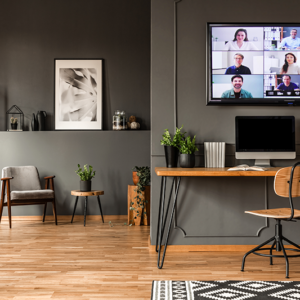Bring in more patrons with upgraded AV systems
The shift to visual and audio communication technology within museums has been steadily increasing in recent years and even more so in the wake of the COVID-19 pandemic. Limited staff, fewer volunteers, and additional safety precautions have obligated many museums to improve their audio-visual (AV) capabilities to continue giving visitors welcoming and immersive experiences. Read on to learn about many of the technological AV advances museums have adopted to increase their popularity and, most importantly, improve their learning environment.
Projector Mapping
Projector mapping is an increasingly popular way to make museum exhibits visually stand out. These experiences show images and videos on walls, floors, ceilings, and other surfaces. Projections are sometimes interactive and can change via motion detection or external controls. Other times, these projections are flat images or videos that scroll along a map path over a surface to give it more depth and activity.
In museums, projector mapping can improve an exhibit, cover a temporarily empty space, properly set the tone for a room, and much more. For example, many museums use projectors to illuminate the floor, archways, or walls near an entrance to make the exhibit more appealing and let visitors know what they can expect to see inside. Other museums and businesses have even used projector mapping outside their buildings to illuminate them at night.
Museums And Experiences Using Projector Mapping
Since 2020, immersive projector experiences have become increasingly popular in the United States. Many museums and experiences specifically focus on artists, projecting their work on walls and surfaces to give visitors more up-close, almost hypnotic looks at their processes. In some cases, the projection mapping is the exhibit, featuring voice-over narration, increasing accessibility through a multimodal experience.
The process of projector mapping can be incredibly tedious, especially when projecting on surfaces with corners. One slightly unaligned projection or calculation could offset the synchrony of the image and take visitors out of the illusion. For this reason, it’s critical for museums to work with AV experts when setting up new projector-mapped exhibits.
Automated vs. Controlled Shows And Exhibits
Many museums have installed automated and controllable shows and exhibits for visitors. This museum AV option has been in use for several decades but is relatively expensive, so only museums and businesses with large budgets could take advantage of this option. Famous examples include the Griffith Observatory, California Science Center, and Disney World’s Hall of Presidents.
Today, automation and show control are more advanced and, in many cases, more affordable for museums to take advantage of. Larger automated shows in museums often serve as their own single-room exhibits with fixed start and end times. However, museum show control can also be as small as an automated component moving in the back of an exhibit or a model train moving along a recreated Old West landscape.
Some shows can be pre-programmed and allowed to run entirely on their own, while other shows must be controlled by an operator. In some situations, an automated show or exhibit may be designed for visitor interaction, such as a motion capture exhibit or a voice-repeater. Show control and automation are technical and usually expensive to set up but can be very popular among guests. An automated show with specific starting times may convince visitors to stay at the museum longer or come back later.
Phone-Based Tour Guide Systems
With shortages of available tour guides and the popularity of cell phones, many museums have adopted phone-based tour guide systems. These are usually available via an app, website, or portable device offered by the museum. Tour systems let museum guests read or, using headphones, listen to information about the exhibits and artwork they see.
Details can include an exhibit’s history, information about the time period, how multiple exhibits connect, and who donated specific exhibits to the museum. While some tour guide systems have a fixed path and narration for guests to follow, many let guests personalize their route and only learn about exhibits they’re interested in.
Compared to other museum AV systems, phone tour guide systems do more than offer guests immersive experiences. Depending on the app, these systems also answer popular questions, work in place of paper maps, and include more building specifics than maps usually communicate, such as bathroom locations, accessibility options, specific exhibits, and show hours. On top of this, app-based tour guide systems can help with branding and marketing, as having an app alert may inspire visitors to visit again.









